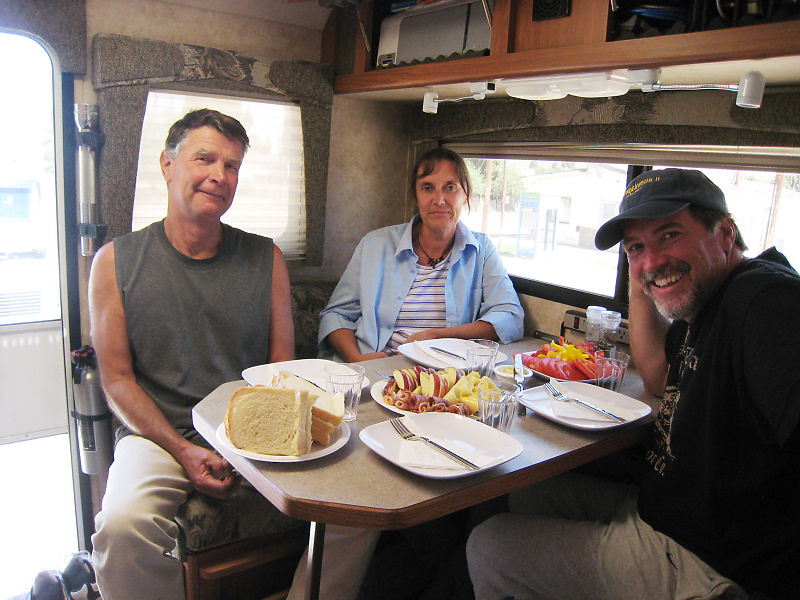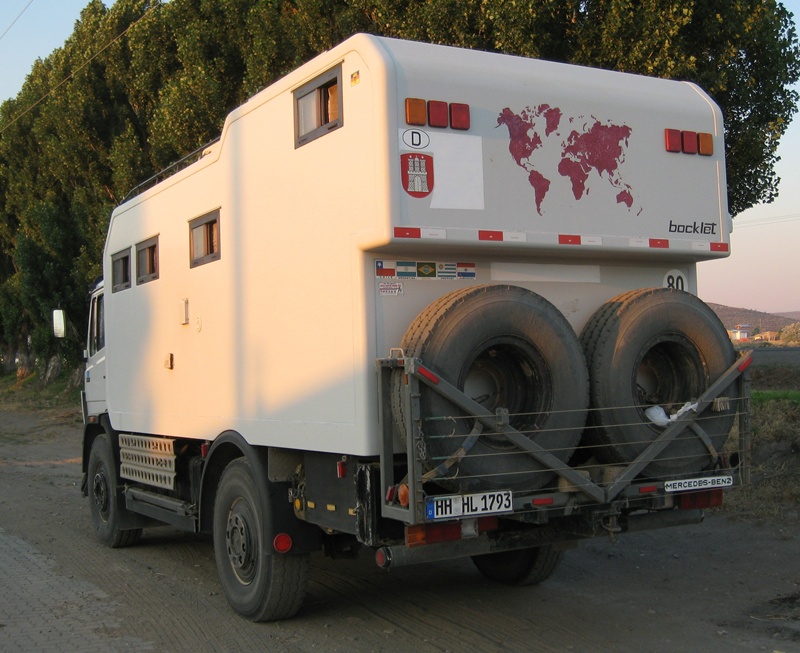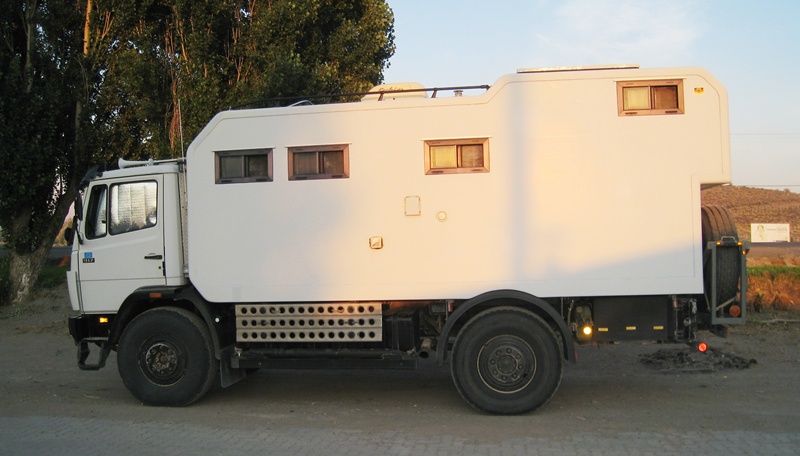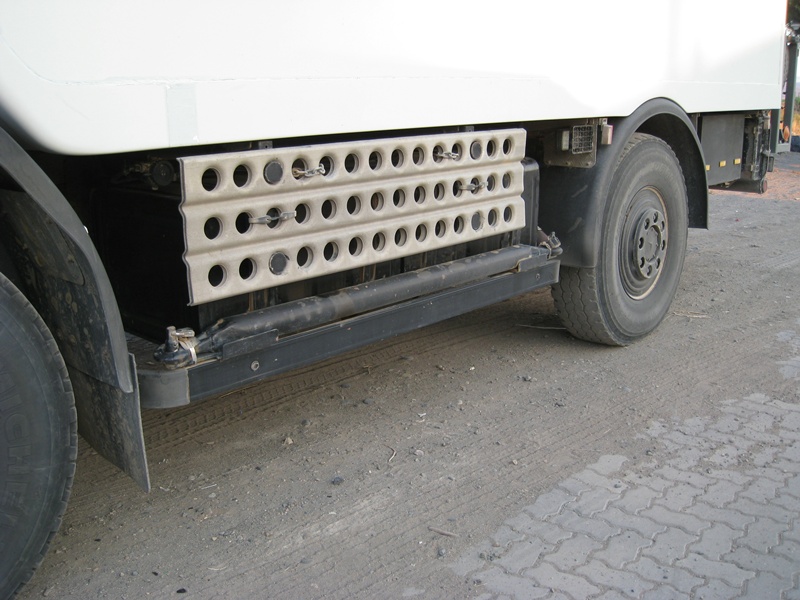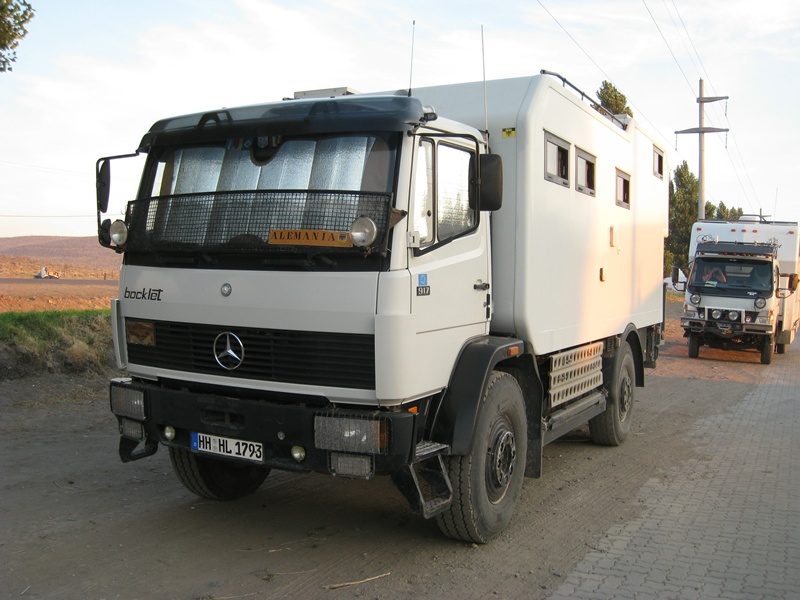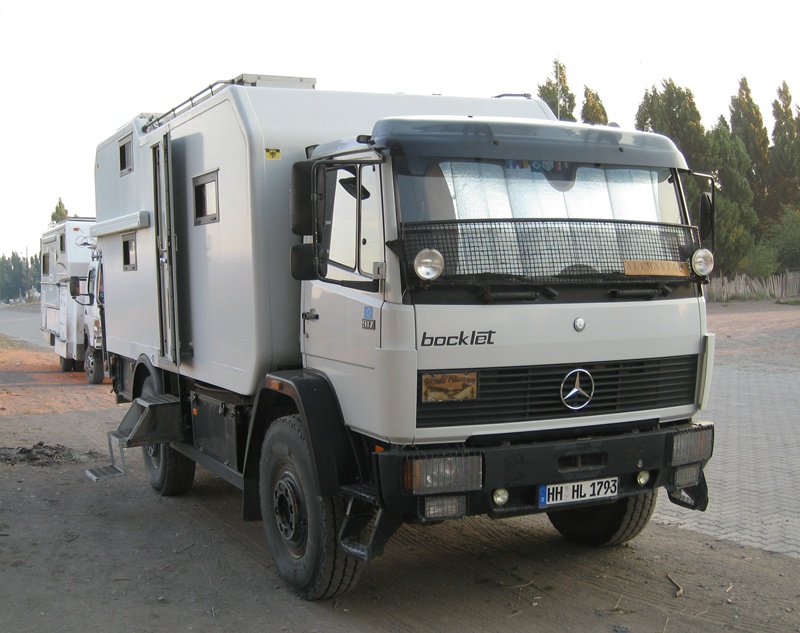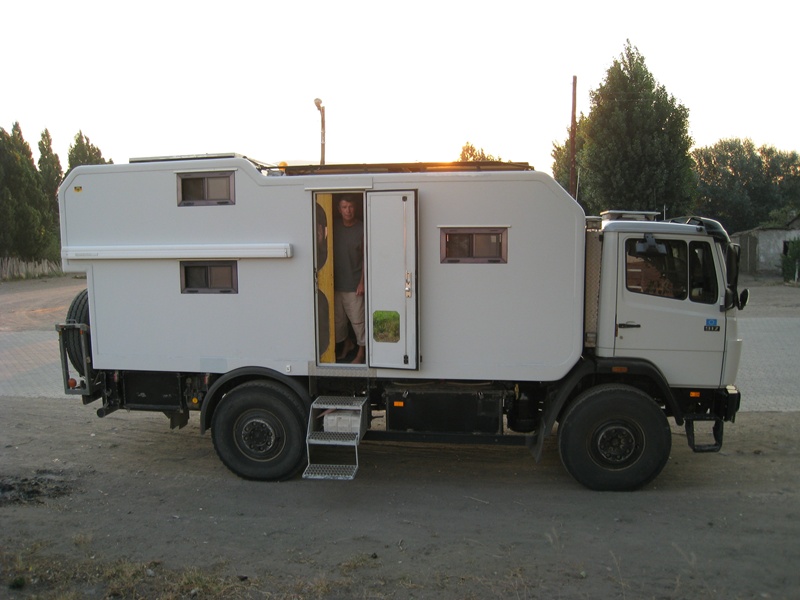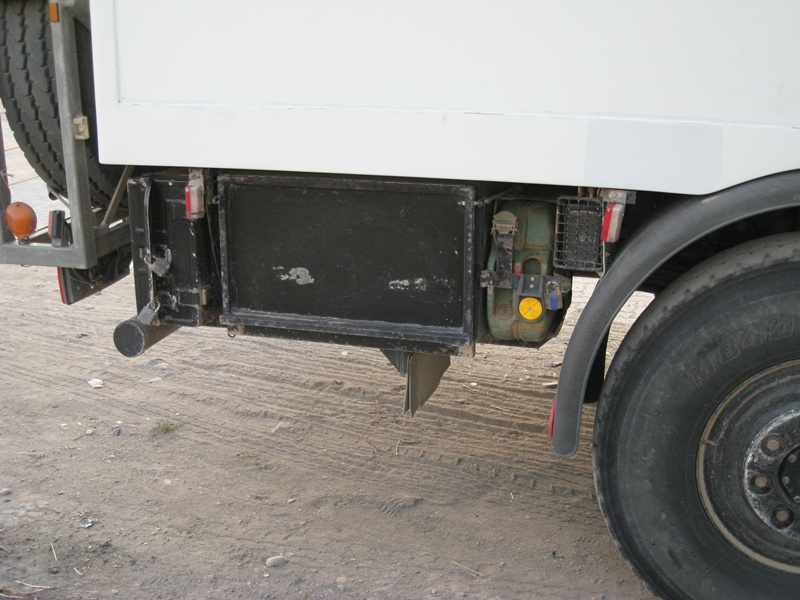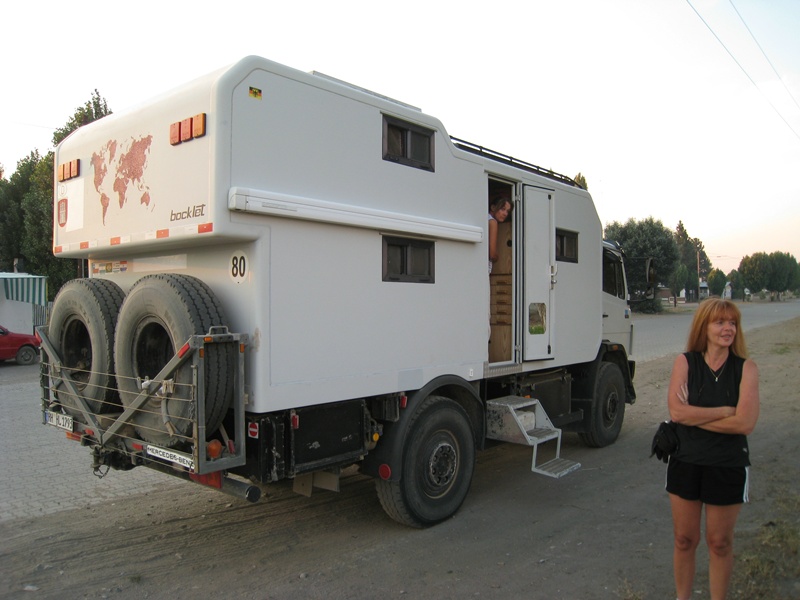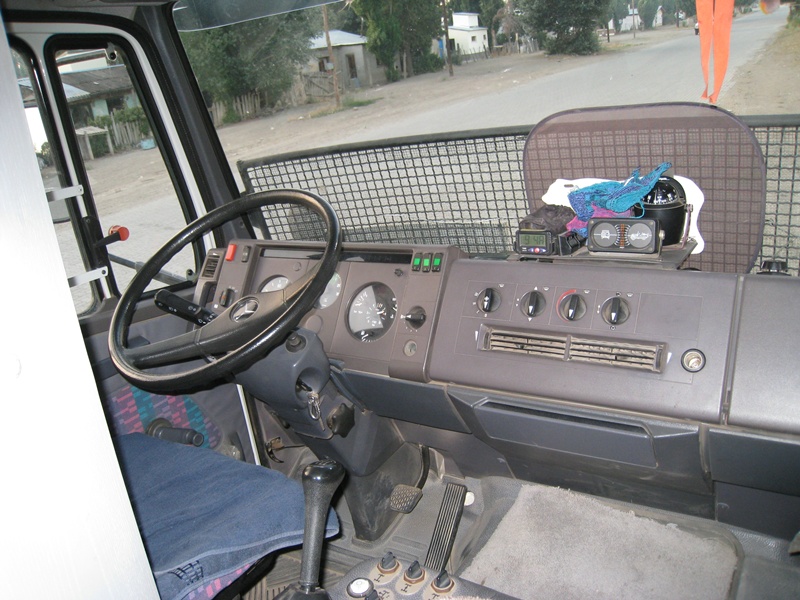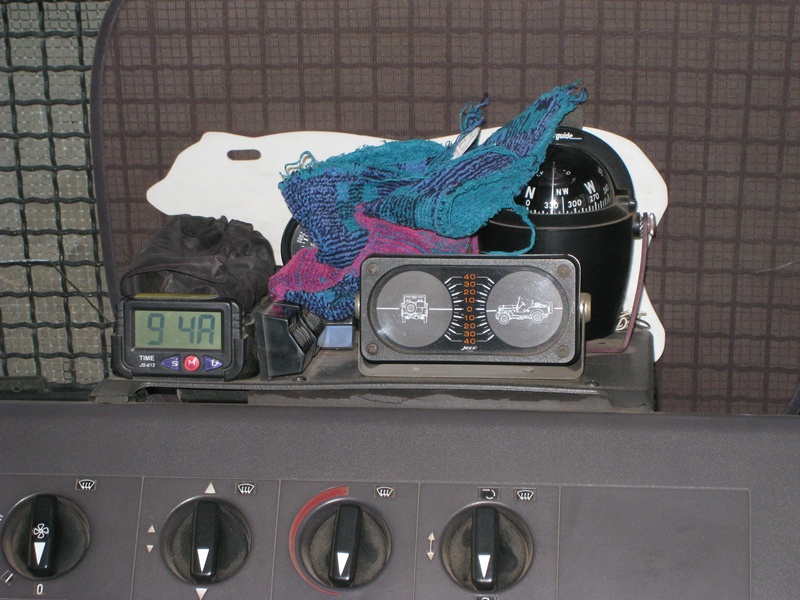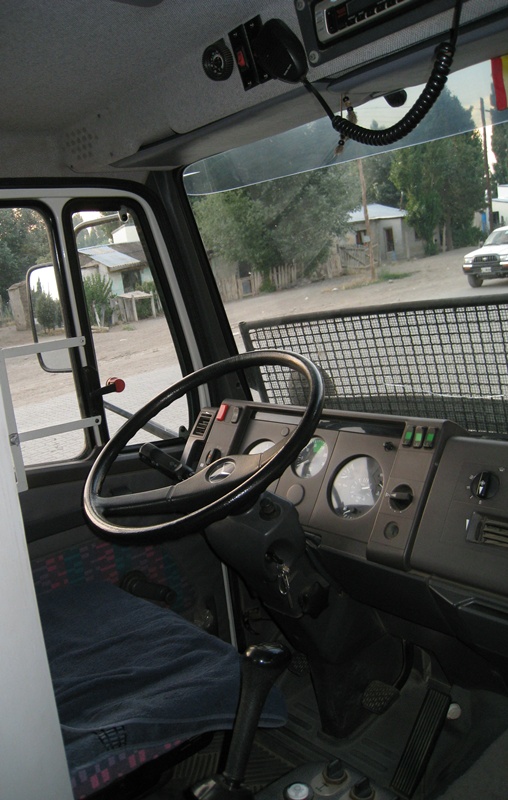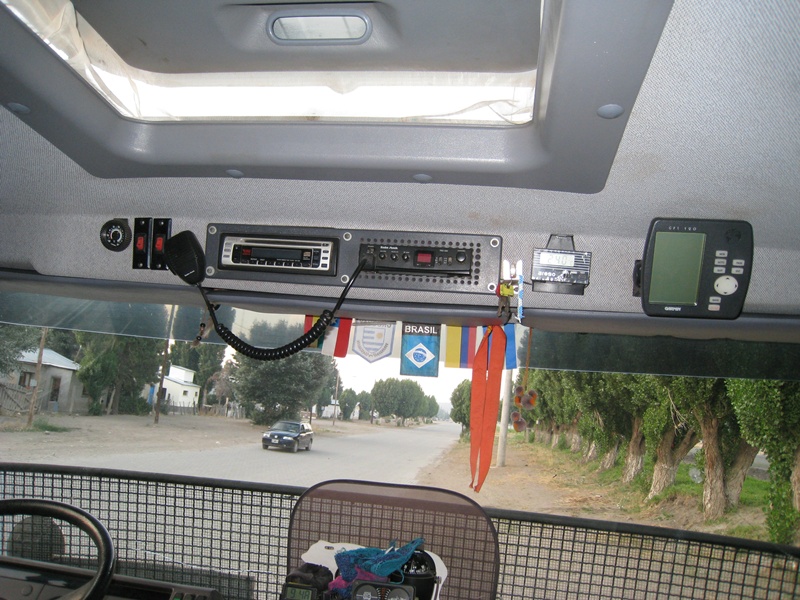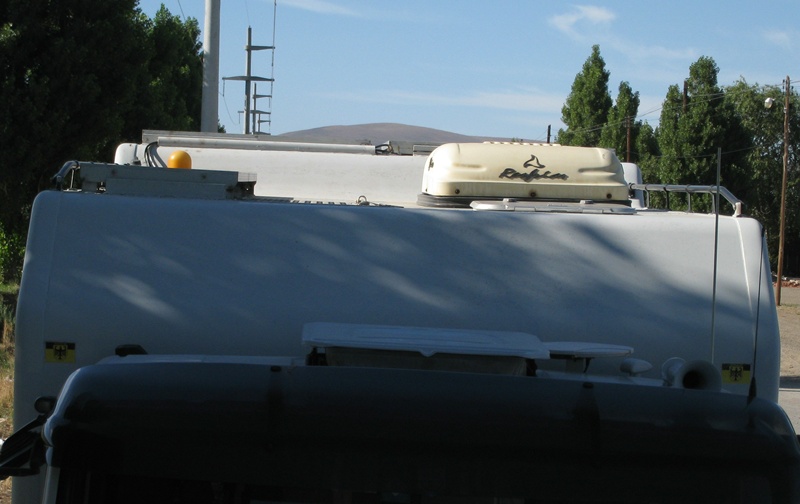dhackney
Expedition Leader
Overlander Interview
Interview date: 6 February, 2008
Location: Tecka, Argentina
Wolf & Ilona Ogorek
Hamburg, Germany
13 years continuous overlanding
Last 7 years in South America
Currently spend most of their time on remote Estancia (ranch) roads in Patagonia in the summer and along the coast of Brazil and in northern Argentina during the winter.
Rig
Chassis: 1995 Mercedes 917 AF (A = 4x4, F = Fire Truck), 300km on chassis. Fire truck variant has several important ruggedized and capability differences with standard 917 A.
Length – 7.3 m / 23.95 ft
Width – 2.5 m / 8.202 ft (max width for Europe)
Height – 3.45 m / 11.32 ft
Weight: 9,000 kilos / 19,842 lbs
Construction: reinforced fiberglass, crawl through cab access, floating pivot frame, owner finished interior (looked unbelievably good after 13 years of full-time use, fantastic), no problems / trouble with the rig after 13 years of continuous use
Systems:
Heat & cooking: Propane (diesel stoves do not work at altitude)
Solar: four panels
Hot water: unknown
Water capacity: unknown
Generator: I did not ask but Wolf did not mention it. I don’t think they carry one.
Electrical: 24 VDC, 220 VAC (I did not observe any 220VAC systems, but they may have a 220VAC battery charger. That is complete speculation on my part, I did not ask about it.)
Air conditioning: rooftop - added after they went to the Amazon basin
Have used their sand ladders a few times, almost always when they did not walk the route to check for surface capability.
Do not have a winch on the rig. A center mounted winch that can be used at either end is available for their chassis.
Were stuck for 48 hours in the salt flats in Bolivia.
Overlanding Rig Comments
Iveco – Make very attractive and handy size 4x4 vans and medium duty trucks. Every owner they have ever met was unhappy and looking to get into a different truck. Lots of problems.
MAN – Very good quality heavy trucks (class 7/8) (require special driver’s license in Germany). Medium duty 4x4 MAN trucks sold to overlanding market have lightweight frames. Wolf has seen multiple examples of frame failures on MAN overlanding rigs. He strongly advocates a minimum frame size of 6mm.
UNIMOG - Every owner they have ever met was unhappy and looking to get into a different chassis. Noisy, uncomfortable, difficult to obtain parts (a UNIMOG is not a standard Mercedes truck which is easy to service and find parts for), etc. [ DH Comment: A UNIMOG is built to cover 99% of the world’s roads / tracks but full time overlanding is almost all about covering somewhere between 70-90% and using other means to cover the rest (local tours, rentals, motorcycles, etc.).]
Estimates there are at least 200 Europeans, mostly Germans, around South America (SA), with more coming all the time due to the strength of the Euro and relatively low cost of SA travel.
Has met a few overlanding Americans in SA over the years, most on motorcycles.
Germany has about 100 builders of overlanding / camping rigs, most on Mercedes chassis, some on MAN. Most are small shops. Quality varies and he has seen examples of small shops’ products that were fundamentally flawed (2,000 kilos on one rear wheel with over 5,000 kilos on the other side, etc.).
Most grievous overlanding rig failures:
- Engine falling out after <200 miles of washboard on a new rig.
- Frame failure (multiple examples, all MAN)
Has traveled with several couples & families with roof top tents. All have given up and returned to work to build up enough cash to buy a rig similar to the Ogorek’s.
A primary failure issue is owners overdriving their rigs for the conditions and route. Some conditions require 20kph (~14mph) and you must go slow to preserve the rig and avoid damage.
Route Comments
Believes we could do all the routes in Brazil (TransAmazon, etc.)(we are in a Fuso FG140 rig). Pointed out that the region is a lot more populated than you would think and people are running up and down all the routes in Fiat Unos and other vehicles with miniscule ground clearance and tiny tires/wheels.
Recommends September for Brazil Amazon routes (dry season), but says that it’s better if it’s a little wet / muddy. If it is completely dry then the route is like concrete – very hard dry ruts, sharp drops / edges, etc. A little mud softens everything and helps the rig.
The bridges in Brazil’s Amazon area are all built for 80,000 lb.+ semi loads and are constructed of large tree logs overlaid with planks (I saw the photos).
In Brazil’s Amazon area if a bridge is broken or you get stuck you just wait and someone will come along to fix the bridge or pull you out. There is a lot of big truck traffic on these roads, so you don’t have to wait long. The really bad sections are worked by guys on Cats who pull you out for cash / produce / drinks / etc.
Quote: “There are no accurate maps of Bolivia.”
Gave us specific roads to avoid in Bolivia. They have been down them and would never try it again.
Said that a stock HiLux 4x4 could do any road in Bolivia.
Bridges in Bolivia are built for light (village roads) to medium duty trucks.
Bridges in Bolivia are built for narrow track vehicles. Indicated that our dual rear wheels and narrow track will be a real advantage there (distribute the weight over a larger contact patch area and the narrow track will match the bridges).
Height and width are the most common limiting factors.
Yellow fever inoculation is required to enter Brazil.
People with dogs often have problems crossing borders.
General
Very engaging, friendly, open, entertaining and helpful couple.
Tremendously experienced in overlanding in general and the Americas in particular.
They have a photo album of the overlanding rigs they’ve encountered over their 13 years with at least 200 shots. It is probably the world’s best collection of overlanding rig photos. Wolf can relate details about every single rig.
Referrals
Their rig was built by Bocklet. They have had no issues with it in 13 years of continuous full-time utilization.
Address:
Bocklet – Fahrzeugbau
Manenfelder Str. 3
5400 Uoblenz
Telephone: 02 61 802 504
Web: www.bockletfarzeugbau.de
They also recommended a young man who has a small shop fabricating rigs. Wolf rated him as 1,000% German, meaning he was fanatical about craftsmanship, quality, details, etc.
Michael Nischwitz
www.crossxroads.de
Michael has dual Canadian / German citizenship and lived in Canada. He speaks English and is familiar with the North American market.
Interview date: 6 February, 2008
Location: Tecka, Argentina
Wolf & Ilona Ogorek
Hamburg, Germany
13 years continuous overlanding
Last 7 years in South America
Currently spend most of their time on remote Estancia (ranch) roads in Patagonia in the summer and along the coast of Brazil and in northern Argentina during the winter.
Rig
Chassis: 1995 Mercedes 917 AF (A = 4x4, F = Fire Truck), 300km on chassis. Fire truck variant has several important ruggedized and capability differences with standard 917 A.
Length – 7.3 m / 23.95 ft
Width – 2.5 m / 8.202 ft (max width for Europe)
Height – 3.45 m / 11.32 ft
Weight: 9,000 kilos / 19,842 lbs
Construction: reinforced fiberglass, crawl through cab access, floating pivot frame, owner finished interior (looked unbelievably good after 13 years of full-time use, fantastic), no problems / trouble with the rig after 13 years of continuous use
Systems:
Heat & cooking: Propane (diesel stoves do not work at altitude)
Solar: four panels
Hot water: unknown
Water capacity: unknown
Generator: I did not ask but Wolf did not mention it. I don’t think they carry one.
Electrical: 24 VDC, 220 VAC (I did not observe any 220VAC systems, but they may have a 220VAC battery charger. That is complete speculation on my part, I did not ask about it.)
Air conditioning: rooftop - added after they went to the Amazon basin
Have used their sand ladders a few times, almost always when they did not walk the route to check for surface capability.
Do not have a winch on the rig. A center mounted winch that can be used at either end is available for their chassis.
Were stuck for 48 hours in the salt flats in Bolivia.
Overlanding Rig Comments
Iveco – Make very attractive and handy size 4x4 vans and medium duty trucks. Every owner they have ever met was unhappy and looking to get into a different truck. Lots of problems.
MAN – Very good quality heavy trucks (class 7/8) (require special driver’s license in Germany). Medium duty 4x4 MAN trucks sold to overlanding market have lightweight frames. Wolf has seen multiple examples of frame failures on MAN overlanding rigs. He strongly advocates a minimum frame size of 6mm.
UNIMOG - Every owner they have ever met was unhappy and looking to get into a different chassis. Noisy, uncomfortable, difficult to obtain parts (a UNIMOG is not a standard Mercedes truck which is easy to service and find parts for), etc. [ DH Comment: A UNIMOG is built to cover 99% of the world’s roads / tracks but full time overlanding is almost all about covering somewhere between 70-90% and using other means to cover the rest (local tours, rentals, motorcycles, etc.).]
Estimates there are at least 200 Europeans, mostly Germans, around South America (SA), with more coming all the time due to the strength of the Euro and relatively low cost of SA travel.
Has met a few overlanding Americans in SA over the years, most on motorcycles.
Germany has about 100 builders of overlanding / camping rigs, most on Mercedes chassis, some on MAN. Most are small shops. Quality varies and he has seen examples of small shops’ products that were fundamentally flawed (2,000 kilos on one rear wheel with over 5,000 kilos on the other side, etc.).
Most grievous overlanding rig failures:
- Engine falling out after <200 miles of washboard on a new rig.
- Frame failure (multiple examples, all MAN)
Has traveled with several couples & families with roof top tents. All have given up and returned to work to build up enough cash to buy a rig similar to the Ogorek’s.
A primary failure issue is owners overdriving their rigs for the conditions and route. Some conditions require 20kph (~14mph) and you must go slow to preserve the rig and avoid damage.
Route Comments
Believes we could do all the routes in Brazil (TransAmazon, etc.)(we are in a Fuso FG140 rig). Pointed out that the region is a lot more populated than you would think and people are running up and down all the routes in Fiat Unos and other vehicles with miniscule ground clearance and tiny tires/wheels.
Recommends September for Brazil Amazon routes (dry season), but says that it’s better if it’s a little wet / muddy. If it is completely dry then the route is like concrete – very hard dry ruts, sharp drops / edges, etc. A little mud softens everything and helps the rig.
The bridges in Brazil’s Amazon area are all built for 80,000 lb.+ semi loads and are constructed of large tree logs overlaid with planks (I saw the photos).
In Brazil’s Amazon area if a bridge is broken or you get stuck you just wait and someone will come along to fix the bridge or pull you out. There is a lot of big truck traffic on these roads, so you don’t have to wait long. The really bad sections are worked by guys on Cats who pull you out for cash / produce / drinks / etc.
Quote: “There are no accurate maps of Bolivia.”
Gave us specific roads to avoid in Bolivia. They have been down them and would never try it again.
Said that a stock HiLux 4x4 could do any road in Bolivia.
Bridges in Bolivia are built for light (village roads) to medium duty trucks.
Bridges in Bolivia are built for narrow track vehicles. Indicated that our dual rear wheels and narrow track will be a real advantage there (distribute the weight over a larger contact patch area and the narrow track will match the bridges).
Height and width are the most common limiting factors.
Yellow fever inoculation is required to enter Brazil.
People with dogs often have problems crossing borders.
General
Very engaging, friendly, open, entertaining and helpful couple.
Tremendously experienced in overlanding in general and the Americas in particular.
They have a photo album of the overlanding rigs they’ve encountered over their 13 years with at least 200 shots. It is probably the world’s best collection of overlanding rig photos. Wolf can relate details about every single rig.
Referrals
Their rig was built by Bocklet. They have had no issues with it in 13 years of continuous full-time utilization.
Address:
Bocklet – Fahrzeugbau
Manenfelder Str. 3
5400 Uoblenz
Telephone: 02 61 802 504
Web: www.bockletfarzeugbau.de
They also recommended a young man who has a small shop fabricating rigs. Wolf rated him as 1,000% German, meaning he was fanatical about craftsmanship, quality, details, etc.
Michael Nischwitz
www.crossxroads.de
Michael has dual Canadian / German citizenship and lived in Canada. He speaks English and is familiar with the North American market.
Last edited:

